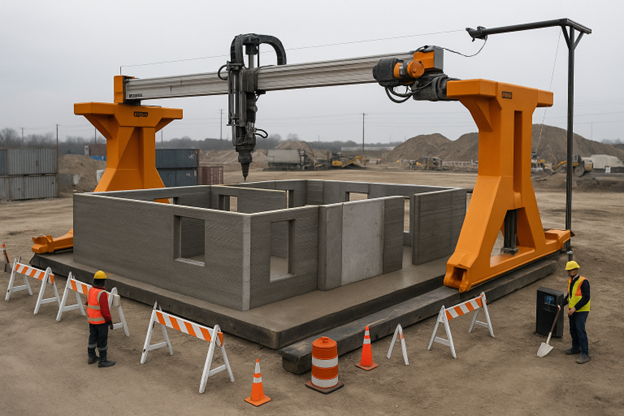As climate change and resource scarcity become pressing global concerns, the construction industry faces growing pressure to adopt sustainable practices. Fortunately, technology is paving the way for greener projects by enabling innovative solutions that reduce waste, conserve energy, and minimize environmental impact. From 3D printing and artificial intelligence (AI) to the Internet of Things (IoT), cutting-edge technologies are transforming the way we design, build, and manage infrastructure.
3D Printing: Reducing Waste and Enhancing Efficiency
3D printing is revolutionizing construction by allowing precise material usage, which significantly reduces waste. This technology uses computer-aided designs (CAD) to create structures layer by layer, enabling unparalleled precision and customization.
Benefits:
- Material Efficiency: Traditional construction methods often involve excess material, but 3D printing uses only what is necessary, reducing waste by up to 60%.
- Sustainable Materials: 3D printing can incorporate recycled or biodegradable materials, further lowering the environmental footprint.
- Faster Construction: Entire structures can be printed in days instead of months, reducing energy consumption on-site.
Case Example: In Dubai, the world’s first 3D-printed office building was completed in 17 days, using less material and labor than conventional methods, setting a benchmark for sustainable construction.
AI-Powered Design and Optimization
Artificial intelligence is enabling smarter, more sustainable construction through optimized designs and predictive analytics. AI can analyze vast datasets to propose designs that minimize material use, energy consumption, and carbon emissions.
Applications:
- Optimized Structural Design: AI algorithms generate designs that use fewer materials while maintaining structural integrity.
- Energy-Efficient Buildings: AI integrates climate data to optimize insulation, ventilation, and solar panel placement for maximum energy efficiency.
- Predictive Maintenance: AI identifies potential issues in existing structures, reducing the need for resource-intensive repairs.
Real-World Impact: Using AI, a construction firm reduced steel usage by 15% in a high-rise building project while maintaining safety and durability standards.
IoT-Enabled Smart Construction: The Internet of Things (IoT) is transforming construction sites into smart, interconnected environments. Sensors, wearables, and connected devices provide real-time data that can improve sustainability across all phases of construction.
Key Contributions:
- Energy Monitoring: IoT sensors track energy usage in real-time, enabling project managers to identify inefficiencies and reduce consumption.
- Material Tracking: IoT systems monitor the delivery and usage of materials, ensuring minimal waste and accurate inventory management.
- Smart Buildings: Post-construction, IoT devices enable buildings to monitor and optimize their energy usage, reducing long-term environmental impact.
Example: A green construction project in Singapore utilized IoT sensors to monitor concrete curing conditions, reducing energy consumption during the curing process by 20%.
Integrated Technologies for a Sustainable Future
The combined power of 3D printing, AI, and IoT is unlocking new levels of sustainability in construction. By integrating these technologies, projects can:
- Achieve Net-Zero Goals: Optimize energy efficiency and reduce carbon emissions.
- Minimize Lifecycle Impact: Use sustainable materials and monitor energy use throughout the building’s lifecycle.
- Enhance Circular Economy Practices: Reuse and recycle materials efficiently, closing the loop on construction waste.
Looking Forward: A Greener Construction Industry
Adopting these technologies is critical for construction firms to remain competitive and comply with evolving regulatory standards. As advancements continue, the potential for greener construction practices will expand, aligning infrastructure development with environmental priorities. DRMcNatty & Associates provides specialized services to integrate these technologies into construction projects, ensuring sustainable outcomes. Our team offers end-to-end support, including technology assessment, system integration, and process optimization.







